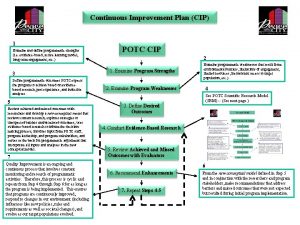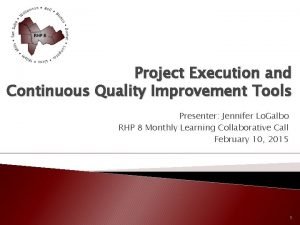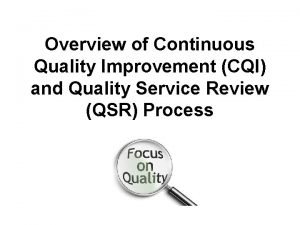Continuous Improvement Plan CIP 1 Examine and define


- Slides: 2

Continuous Improvement Plan (CIP) 1 Examine and define programmatic strengths (i. e. evidence-based, active learning model, long-term engagement, etc. ) 3 Define programmatic outcomes POTC expects the program to achieve based on evidencebased research, past experience, and inductive analyses. 5 Review achieved and missed outcomes with researchers and develop a new conceptual model that reviews current research; explores strategies to unexpected barriers and/or missed outcomes; uses evidence-based research to inform the decisionmaking process; involves input from POTC staff, program leadership, and program stakeholders; and serves as the basis for programmatic adjustment that incorporate all inputs and analyses in the new conceptual model. 7 Quality Improvement is an ongoing and continuous process that involves constant monitoring and research of programmatic activities. Therefore, this process is cyclic and repeats from Step 4 through Step 6 for as long as the program is being implemented. This ensures that programs are continuously improved, respond to changes in our environment (including influences like new policies, rules and requirements as well as societal changes), and evolve as our target populations evolved. POTC CIP 2 1. Examine Program Strengths Examine programmatic weaknesses that result from environmental barriers, limitations of engagement, limited resources, inconsistent access to target population, etc. ). 2. Examine Program Weaknesses 3. Define Desired Outcomes 4 See POTC Scientific Research Model (SRM) -- (See next page. ) 4. Conduct Evidence-Based Research 5. Review Achieved and Missed Outcomes with Evaluators 6 6. Recommend Enhancements 7. Repeat Steps 4 -5 From the new conceptual model defined in Step 5 and in conjunction with the researchers and program stakeholders, make recommendations that address barriers and missed outcomes that were not expected but resulted during initial program implementation.

Research Model 1 Examine and define Demographic & Baseline data, Provider Characteristics (including partners), Project Characteristics, and Project Management/Implementation Plan 3 For each activity identified in the Environment, describe in general terms what will occur (the output), including specific resources that connect to each activity (output). 5 Define the Outcomes to be examined, the Target Indicators or quantifiable goals for each Outcome, Data Sources, and Data Collection Methodology. This format should be constructed as a table (see Evaluation & Mapping Documents) and should be as clearly defined as possible. All Longitudinal studies should be publishable quality and therefore aim to meet the highest level of scientific rigor. 7 The primary goal of research is to increase the efficacy of POTC programs. To this end, the result of all research studies should be rigorous. Peer review journals are the goal but trade/educational journals/white papers are Acceptable forms of reporting the results. POTC Research Model 2 1. Examine Inputs Define the environment in which the program will take place, including what Activities will take place and what resources will be distributed. 2. Define Environment 3. Define Outputs 4. Define Outcomes: Initial, Intermediate, & Impact 5. Construct Longitudinal Study 6. Conduct Study 7. Report/Publish Results 4 There will need to be three levels of outcomes defined: Initial (attitudinal), Intermediate (behavioral), and Impact (actual change). The research should focus on examining the Impact Outcome while evaluation examines the other two. Impact Outcomes are always quantifiable. 6 For each study conducted, you must ensure that your research model is clearly defined (#1 - #5) and that implementation is constant (any variance in program implementation may greatly impact the reliability of your research). Whenever possible, align with a professional researcher to increase credibility and quality of the research.



